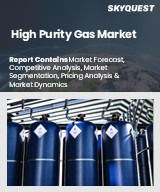
|
시장보고서
상품코드
1775658
고순도 가스 시장 규모, 점유율, 성장 분석 : 유형별, 기능별, 제조 공정별, 보관, 배송, 운송별, 최종 용도 산업별, 지역별 - 산업 예측(2025-2032년)High Purity Gas Market Size, Share, and Growth Analysis, By Type (High Atmospheric Gas, Noble Gas), By Function (Insulation, Illumination), By Manufacturing Process, By Storage, By End-Use Industry, By Region - Industry Forecast 2025-2032 |
||||||
세계의 고순도 가스 시장 규모는 2023년에 336억 달러로 평가되며, 2024년 358억 8,000만 달러에서 2032년에는 607억 4,000만 달러로 성장하며, 예측 기간(2025-2032년)의 CAGR은 6.8%로 성장할 전망입니다.
세계 고순도 가스 시장은 전자 산업, 화학 및 야금 산업, 헬스케어 인프라의 발전과 같은 분야의 활발한 산업 활동으로 인해 크게 성장하고 있습니다. 그린 수소 및 청정 에너지 솔루션에 대한 수요가 급증하고 있으며, 저장 및 탄산화를 위해 이러한 가스에 의존하는 포장 식품 및 음료 부문의 확장과 함께 시장 전망을 높이고 있습니다. 또한 반도체 분야의 생산 공정에서 고순도 가스의 중요한 역할이 수요를 주도하고 있습니다. 그러나 높은 처리 비용, 규제 장벽, 공급망 혼란, 개발도상국의 열악한 인프라 등의 문제가 성장을 저해하는 요인으로 작용할 수 있습니다. 이러한 제약에도 불구하고 시장은 여전히 역동적이며, 지속적인 산업 및 기술 발전으로 인해 큰 비즈니스 기회를 창출하고 있습니다.
목차
서론
- 조사의 목적
- 조사 범위
- 정의
조사 방법
- 정보 조달
- 2차와 1차 데이터 방법
- 시장 규모 예측
- 시장의 전제조건과 제한
개요
- 세계 시장 전망
- 공급과 수요 동향 분석
- 부문별 기회 분석
시장 역학과 전망
- 시장 개요
- 시장 규모
- 시장 역학
- 촉진요인과 기회
- 억제요인과 과제
- Porter의 산업 분석
주요 시장 인사이트
- 주요 성공 요인
- 경쟁의 정도
- 주요 투자 기회
- 시장 에코시스템
- 시장의 매력 지수(2024년)
- PESTEL 분석
- 거시경제 지표
- 밸류체인 분석
- 가격 분석
- 사례 연구
- 규제 분석
고순도 가스 시장 규모 : 유형별 & CAGR(2025-2032)
- 시장 개요
- 고층 대기 가스
- 희가스
- 탄산 가스
- 기타 가스 유형
고순도 가스 시장 규모 : 기능별 & CAGR(2025-2032)
- 시장 개요
- 절연
- 조명
- 냉각제
고순도 가스 시장 규모 : 제조 공정별 & CAGR(2025-2032)
- 시장 개요
- 공기 분리 기술
- 수소 제조
고순도 가스 시장 규모 : 보관·배송·운송별 & CAGR(2025-2032)
- 시장 개요
- 실린더/패키지 가스
- 머천트 리퀴드
- 톤수
고순도 가스 시장 규모 : 최종 용도 산업별 & CAGR(2025-2032)
- 시장 개요
- 일렉트로닉스
- 금속 생산
- 화학제품
- 석유 및 가스
- 의료·헬스케어
- 식품 및 음료
- 기타 최종 용도 산업
고순도 가스 시장 규모 : 지역별 & CAGR(2025-2032)
- 북미
- 미국
- 캐나다
- 유럽
- 독일
- 스페인
- 프랑스
- 영국
- 이탈리아
- 기타 유럽 지역
- 아시아태평양
- 중국
- 인도
- 일본
- 한국
- 기타 아시아태평양
- 라틴아메리카
- 브라질
- 기타 라틴아메리카 지역
- 중동 및 아프리카
- GCC 국가
- 남아프리카공화국
- 기타 중동 및 아프리카
경쟁 정보
- 상위 5사의 비교
- 주요 기업의 시장 포지셔닝(2024년)
- 주요 시장 기업이 채택한 전략
- 최근 시장 동향
- 기업의 시장 점유율 분석(2024년)
- 주요 기업의 기업 개요
- 기업의 상세
- 제품 포트폴리오 분석
- 기업의 부문별 점유율 분석
- 매출의 전년대비 비교(2022-2024년)
주요 기업 개요
- Air Liquide
- Air Products and Chemicals, Inc.
- Iwatani Corporation
- Matheson Tri Gas, Inc.
- Daigas Group
- Nippon Sanso Holdings Corporation
- Sol India Private Limited
- Ingas
- Gruppo SIAD
- Resonac Holdings Corporation
- LLC Akela N
- Alchemie Gases & Chemicals Pvt. Ltd.
- Bhuruka Gases Limited
- Ultra Pure Gases(I) Pvt. Ltd.
- Seralgaz
- PurityPlus
- Woikoski Oy
- Specialty Gases Company Limited
- Amar Gases
결론과 제안
KSA 25.07.31Global High Purity Gas Market size was valued at USD 33.6 billion in 2023 and is poised to grow from USD 35.88 billion in 2024 to USD 60.74 billion by 2032, growing at a CAGR of 6.8% during the forecast period (2025-2032).
The global high purity gas market is witnessing significant growth fueled by the booming electronics industry, heightened industrial activities across sectors like chemicals and metallurgy, and advancements in healthcare infrastructure. The surge in demand for green hydrogen and clean energy solutions enhances the market's prospects, alongside the expansion of the packaged food and beverage sector that relies on these gases for preservation and carbonation. Additionally, the critical role of high purity gases in production processes within the semiconductor sector is driving demand. However, challenges such as high processing costs, regulatory hurdles, supply chain disruptions, and inadequate infrastructure in developing regions could impede growth. Despite these constraints, the market remains dynamic, presenting substantial opportunities driven by ongoing industrial and technological advancements.
Top-down and bottom-up approaches were used to estimate and validate the size of the Global High Purity Gas market and to estimate the size of various other dependent submarkets. The research methodology used to estimate the market size includes the following details: The key players in the market were identified through secondary research, and their market shares in the respective regions were determined through primary and secondary research. This entire procedure includes the study of the annual and financial reports of the top market players and extensive interviews for key insights from industry leaders such as CEOs, VPs, directors, and marketing executives. All percentage shares split, and breakdowns were determined using secondary sources and verified through Primary sources. All possible parameters that affect the markets covered in this research study have been accounted for, viewed in extensive detail, verified through primary research, and analyzed to get the final quantitative and qualitative data.
Global High Purity Gas Market Segments Analysis
Global High Purity Gas Market is segmented by Type, Function, Manufacturing Process, Storage, End-Use Industry and region. Based on Type, the market is segmented into High Atmospheric Gas, Noble Gas, Carbon Gas and Other Types of Gas. Based on Function, the market is segmented into Insulation, Illumination and Coolant. Based on Manufacturing Process, the market is segmented into Air Separation Technology and Hydrogen Production. Based on Storage, the market is segmented into Cylinders/Packaged Gas, Merchant Liquid and Tonnage. Based on End-Use Industry, the market is segmented into Electronics, Metal Production, Chemicals, Oil & Gas, Medical & Healthcare, Food & Beverage and Other End-Use Industries. Based on region, the market is segmented into North America, Europe, Asia Pacific, Latin America and Middle East & Africa.
Driver of the Global High Purity Gas Market
The rapid expansion of the electronics industry significantly contributes to the growth of the high purity gas market, particularly in the manufacturing of semiconductors and microchips. The requirement for ultra-pure gases is essential in various processes such as etching, cleaning, and deposition within these applications. As consumer demand for advanced technologies, including smartphones, electric vehicles, and smart devices, escalates, the need for these gases rises correspondingly. This surge in production and technological advancement across global markets underscores the critical role that high purity gases play in supporting the evolving landscape of electronic manufacturing.
Restraints in the Global High Purity Gas Market
Market analysis highlights that elevated processing costs pose a significant challenge within the global high purity gas sector. The production of ultra-pure gases necessitates intricate purification processes, cutting-edge equipment, and strict quality assurance measures, all of which contribute to higher operational expenses. These increased costs can limit the accessibility of high purity gases and hinder profitability, particularly impacting small and medium-sized producers who may struggle to compete with larger entities. As a result, the financial burden associated with achieving the required purity standards can impede growth and innovation within the industry.
Market Trends of the Global High Purity Gas Market
The Global High Purity Gas market is witnessing a significant upward trend, driven by the escalating rise of the green hydrogen economy. As nations accelerate their efforts towards achieving net-zero emissions, the demand for ultra-pure hydrogen and oxygen, essential for green hydrogen production through electrolysis, is surging. This burgeoning sector is further fueled by industrial decarbonization initiatives, expansive global hydrogen strategies, and substantial government investments. Consequently, high purity gases are positioned to play a pivotal role in the clean energy transition, making this market segment an increasingly vital driver for sustainable industrial practices and innovative energy solutions in the foreseeable future.
Table of Contents
Introduction
- Objectives of the Study
- Scope of the Report
- Definitions
Research Methodology
- Information Procurement
- Secondary & Primary Data Methods
- Market Size Estimation
- Market Assumptions & Limitations
Executive Summary
- Global Market Outlook
- Supply & Demand Trend Analysis
- Segmental Opportunity Analysis
Market Dynamics & Outlook
- Market Overview
- Market Size
- Market Dynamics
- Drivers & Opportunities
- Restraints & Challenges
- Porters Analysis
- Competitive rivalry
- Threat of substitute
- Bargaining power of buyers
- Threat of new entrants
- Bargaining power of suppliers
Key Market Insights
- Key Success Factors
- Degree of Competition
- Top Investment Pockets
- Market Ecosystem
- Market Attractiveness Index, 2024
- PESTEL Analysis
- Macro-Economic Indicators
- Value Chain Analysis
- Pricing Analysis
- Case Studies
- Regulatory Analysis
Global High Purity Gas Market Size by Type & CAGR (2025-2032)
- Market Overview
- High Atmospheric Gas
- Noble Gas
- Carbon Gas
- Other Types of Gas
Global High Purity Gas Market Size by Function & CAGR (2025-2032)
- Market Overview
- Insulation
- Illumination
- Coolant
Global High Purity Gas Market Size by Manufacturing Process & CAGR (2025-2032)
- Market Overview
- Air Separation Technology
- Hydrogen Production
Global High Purity Gas Market Size by Storage & Distribution and Transportation & CAGR (2025-2032)
- Market Overview
- Cylinders/Packaged Gas
- Merchant Liquid
- Tonnage
Global High Purity Gas Market Size by End-Use Industry & CAGR (2025-2032)
- Market Overview
- Electronics
- Metal Production
- Chemicals
- Oil & Gas
- Medical & Healthcare
- Food & Beverage
- Other End-Use Industries
Global High Purity Gas Market Size & CAGR (2025-2032)
- North America (Type, Function, Manufacturing Process, Storage & Distribution and Transportation, End-Use Industry)
- US
- Canada
- Europe (Type, Function, Manufacturing Process, Storage & Distribution and Transportation, End-Use Industry)
- Germany
- Spain
- France
- UK
- Italy
- Rest of Europe
- Asia Pacific (Type, Function, Manufacturing Process, Storage & Distribution and Transportation, End-Use Industry)
- China
- India
- Japan
- South Korea
- Rest of Asia-Pacific
- Latin America (Type, Function, Manufacturing Process, Storage & Distribution and Transportation, End-Use Industry)
- Brazil
- Rest of Latin America
- Middle East & Africa (Type, Function, Manufacturing Process, Storage & Distribution and Transportation, End-Use Industry)
- GCC Countries
- South Africa
- Rest of Middle East & Africa
Competitive Intelligence
- Top 5 Player Comparison
- Market Positioning of Key Players, 2024
- Strategies Adopted by Key Market Players
- Recent Developments in the Market
- Company Market Share Analysis, 2024
- Company Profiles of All Key Players
- Company Details
- Product Portfolio Analysis
- Company's Segmental Share Analysis
- Revenue Y-O-Y Comparison (2022-2024)
Key Company Profiles
- Air Liquide
- Company Overview
- Business Segment Overview
- Financial Updates
- Key Developments
- Air Products and Chemicals, Inc.
- Company Overview
- Business Segment Overview
- Financial Updates
- Key Developments
- Iwatani Corporation
- Company Overview
- Business Segment Overview
- Financial Updates
- Key Developments
- Matheson Tri Gas, Inc.
- Company Overview
- Business Segment Overview
- Financial Updates
- Key Developments
- Daigas Group
- Company Overview
- Business Segment Overview
- Financial Updates
- Key Developments
- Nippon Sanso Holdings Corporation
- Company Overview
- Business Segment Overview
- Financial Updates
- Key Developments
- Sol India Private Limited
- Company Overview
- Business Segment Overview
- Financial Updates
- Key Developments
- Ingas
- Company Overview
- Business Segment Overview
- Financial Updates
- Key Developments
- Gruppo SIAD
- Company Overview
- Business Segment Overview
- Financial Updates
- Key Developments
- Resonac Holdings Corporation
- Company Overview
- Business Segment Overview
- Financial Updates
- Key Developments
- LLC Akela N
- Company Overview
- Business Segment Overview
- Financial Updates
- Key Developments
- Alchemie Gases & Chemicals Pvt. Ltd.
- Company Overview
- Business Segment Overview
- Financial Updates
- Key Developments
- Bhuruka Gases Limited
- Company Overview
- Business Segment Overview
- Financial Updates
- Key Developments
- Ultra Pure Gases (I) Pvt. Ltd.
- Company Overview
- Business Segment Overview
- Financial Updates
- Key Developments
- Seralgaz
- Company Overview
- Business Segment Overview
- Financial Updates
- Key Developments
- PurityPlus
- Company Overview
- Business Segment Overview
- Financial Updates
- Key Developments
- Woikoski Oy
- Company Overview
- Business Segment Overview
- Financial Updates
- Key Developments
- Specialty Gases Company Limited
- Company Overview
- Business Segment Overview
- Financial Updates
- Key Developments
- Amar Gases
- Company Overview
- Business Segment Overview
- Financial Updates
- Key Developments



















